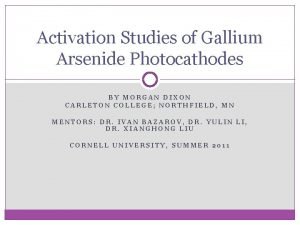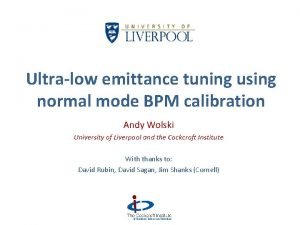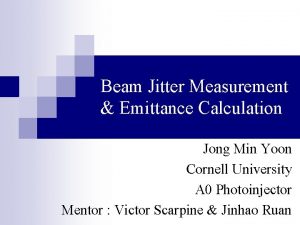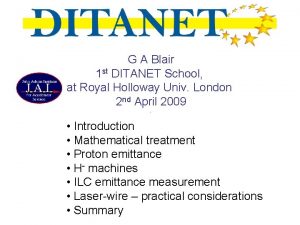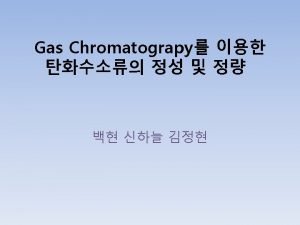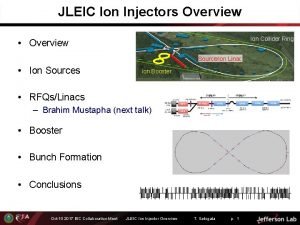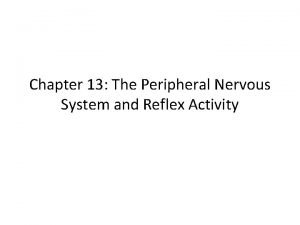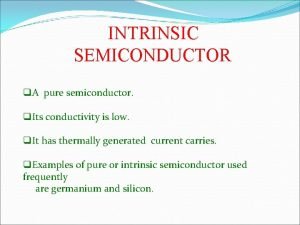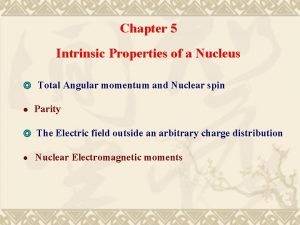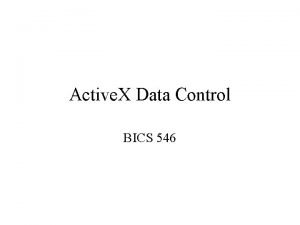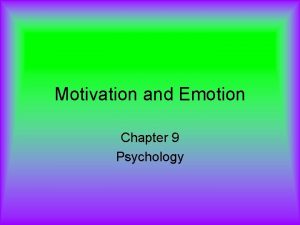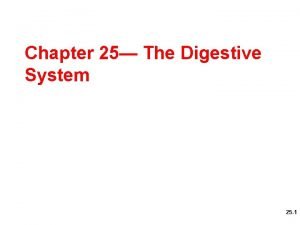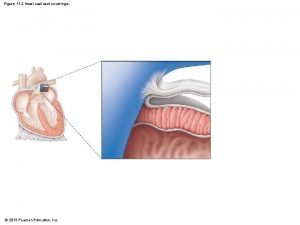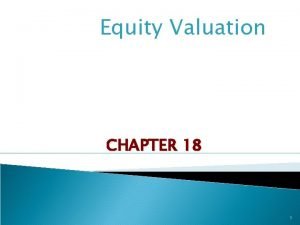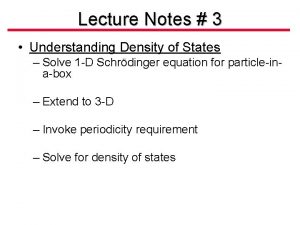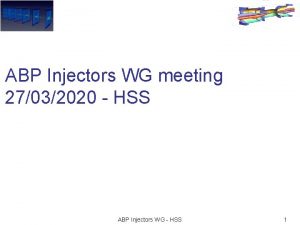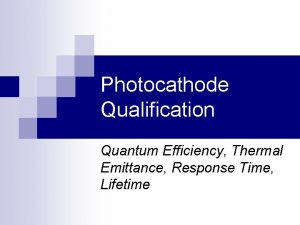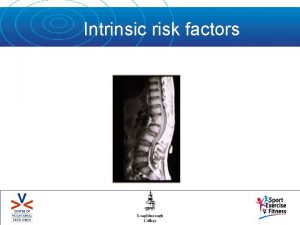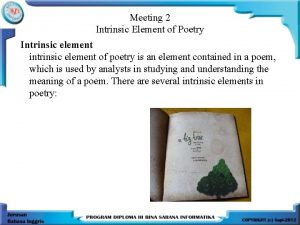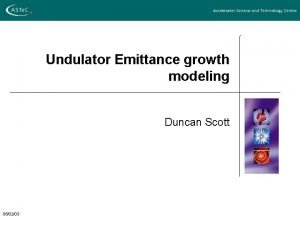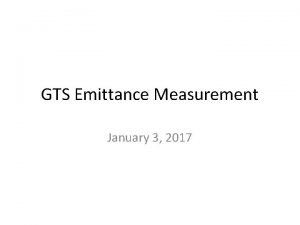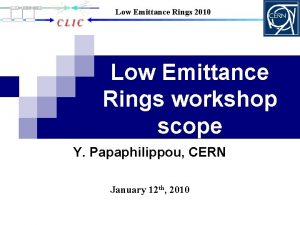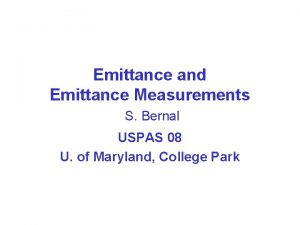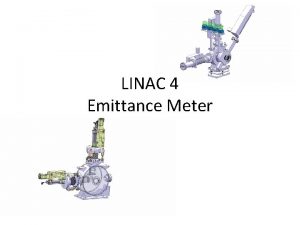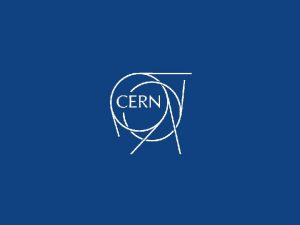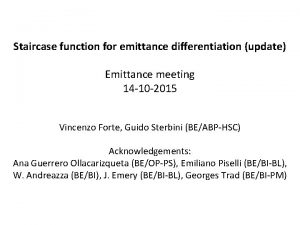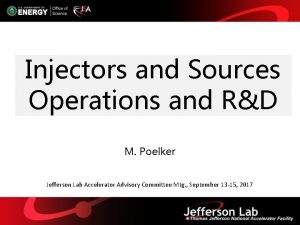Sources of Emittance in Photocathode Injectors Intrinsic emittance
























- Slides: 24

Sources of Emittance in Photocathode Injectors: Intrinsic emittance, space charge emittance due to nonuniformities, optical aberrations David H. Dowell SLAC National Accelerator Laboratory Jefferson Lab October 2016 http: //arxiv. org/abs/1610. 01242

The injector configuration depends upon the cathode field and gun voltage DC or low frequency (100’s MHz) RF gun requires compressing the bunch before accelerating to high energy. Therefore the DC photoinjector includes a RF buncher with two matching solenoids: DC to 100’s MHz solenoid 1 solenoid 2 DC gun linac RF buncher The high field (GHz to THz? ) RF gun begins with a short bunch and rapidly accelerates it to relativistic energy and needs only one matching solenoid: solenoid RF gun linac D. H. Dowell -- Jefferson Lab Seminar Analysis described here can be applied to either configuration. However this talk will mostly discuss the RF photoinjector. 2

Emittance generating processes vs. distance from the cathode surface. D. H. Dowell -- Jefferson Lab Seminar 3

Comparison of the three surface emittances Intrinsic Emittance Rough Surface Emittance Applied Field Emittance See D. H. Dowell, 2012 P 3 Workshop D. H. Dowell -- Jefferson Lab Seminar 4

Intrinsic Emittance Effective mass determines the Intrinsic emittance and QE qout Vacuum Transverse momentum is continuous across the cathode/vacuum boundary Cathode qin Snell’s Law for photoemission Escape momentum: the escape cone angle is larger for m* > m, this increases QE, but also increases emittance D. H. Dowell -- Jefferson Lab Seminar 5

Studies of the Effective Mass could lead to Ultra-Small Intrinsic Emittance Because the effective mass is a tensor it can be described in terms of its longitudinal and transverse components, C. Kittel, ‘Introduction to Solid State Physics’, page 205, 8 th edition. Work on semimetals possessing things called Dirac points and cones illustrates how the effective mass can become zero near the bottom of a band how massless electrons can be produced in a material. See for example, Akrap et al. , “Magneto-Optical Signature of Massless Kane Electrons in Cd 3 As 2, PRL 117, 136401 (2016). It’s important to study photoemission from these states as they could lead to ultra-small intrinsic emittance. D. H. Dowell -- Jefferson Lab Seminar 6

Charge Density Modulations of Surface Roughness and QE Non-Uniformity Longitudinal position, (microns) Electrons are focused and go through a crossover a few mm from the cathode. Space-Charge Emittance due to Non-uniform Emission & Clustering The space charge emittance near the cathode is driven by: -Roughness focusing the beam to produce density modulations near the cathode. -Non-uniform emission due to patchwork of QE variations from different work functions of grain and crystalline orientations as well as due to local QE Uniformity contamination. Non-Uniform Emission Surface Roughness transverse position (microns) For both sources of non-uniformity, there needs to be a model for the space charge effects. This s-c model can be common to both.

Space-Charge Emittance due to Non-uniform Emission & Clustering Beamlet Model for Space-Charge Emittance of a Transverse Modulation of Charge Density The beamlet space charge model assumes a beam transverse distribution with overall radius R and full length lb composed of a large number of beamlets in a rectangular pattern as shown. The transverse spacecharge force causes each beamlet to expand merge with its neighboring beamlets. This radial acceleration gives the beamlets additional transverse momentum leading to larger emittance for the total beam. A basic assumption of the model is that the transverse space charge force goes to zero once the beamlets merge and form an approximately uniform distribution. Thus after merging the non-uniformity becomes washed out and the space charge emittance becomes constant. D. H. Dowell -- Jefferson Lab Seminar rm 8

Space-Charge Emittance due to Non-uniform Emission & Clustering Solution of relativistic radial eqn. of motion with s-c for constant acceleration from rest Radial envelope eqn. of motion Lawson’s relativistic generalized perveance, D. H. Dowell -- Jefferson Lab Seminar Doesn’t include RF focusing effects GPT simulation 9

Space-charge emittance of a uniform mesh of beamlets Space-Charge Emittance due to Non-uniform Emission & Clustering The normalized emittance for an uncorrelated distribution in xx’ phase space is assume the electrons diverge radially from the center of each beamlet and the emission from the finely distributed beamlets is all the same. Thus, the emittance is due to the beamlet divergence uniformly distributed across the full beam area and is then the beamlet divergence times the full beam size. This same approach is used to compute the intrinsic emittance. one then gets D. H. Dowell -- Jefferson Lab Seminar 10

Space-charge emittance for a uniform mesh of beamlets Space-Charge Emittance due to Non-uniform Emission & Clustering Since the full beam current of all the beamlets is I, the current of a single beamlet would be I divided by the number of beamlets. The number of beamlets is the full beam area in units of ns or The beamlet current is the total current divided by the number of beamlets, The emittance is: D. H. Dowell -- Jefferson Lab Seminar Close to the cathode: 11

RF Emittances due to Optical Aberrations The total emittance can be expanded in powers of the rms bunch length, sf , and combined as the sum of the squares of the first-order and second-order RF emittances. The total RF emittance is given as, The first- and second-order emittances have been computed by Kim which here are written as the sum in quadrature, Here σx is the rms beam size and σϕis the rms bunch length in radians at the RF frequency. Both are evaluated at the exit of the gun where the bunch-rf phase is given by fe. Erf is the peak RF field of the gun and is the electron phase relative to the RF waveform when the electron bunch reaches the exit of the gun. The RF emittance is the emittance due to the time-dependent RF lens of the gun and is minimized by having the bunch on crest at the exit of the last gun cell as well as by balancing the cell-to cell RF field amplitudes. D. H. Dowell -- Jefferson Lab Seminar 12

Chromatic Aberration of the Gun Solenoid D. H. Dowell -- Jefferson Lab Seminar Emittances due to Optical Aberrations 13

The Solenoid’s Geometric Aberration Emittances due to Optical Aberrations Simulations were performed with only the solenoid followed by a simple drift. Maxwell’s equations were used to extrapolate the measured axial magnetic field, Bz(z), to obtain the radial fields [20]. The axial field is shown below in Figure 135. Following tradition, the aberration is illustrated using an initial beam square, 2 mm, distribution. The simulation assumed perfect collimation (zero divergence = zero emittance), zero energy spread an energy of 6 Me. V. The transverse beam profiles show an otherwise “perfect” solenoid produces the characteristic “pincushion” distortion. A 4 mm (edge-to-edge) object gives 0. 01 micron rms emittance, while 2 mm square results in only 0. 0025 microns. Ray tracing simulation of the geometric aberration of the LCLS gun solenoid. Left: the initial transverse particle distribution before the solenoid with zero emittance and energy spread. Center: The transverse beam distribution occurring slightly before the beam focus after the solenoid illustrating the third-order distortion. Right: The beam distribution immediately after the beam focus showing the third-order distortion evolving into the iconic “pincushion” shape of the rotated geometric aberration. D. H. Dowell -- Jefferson Lab Seminar The geometric aberration for the gun solenoid: emittance vs. the x-rms beam size at the lens. The simulation (points) used the axial magnetic field measured for the LCLS solenoid. The initial beam has zero emittance and zero energy spread. 14

Quadrupole Field Errors in a Solenoid Magnetic measurements showed small quadrupole fields at the ends of the LCLS solenoid with equivalent focal lengths at 6 Me. V of 20 to 30 meters for the solenoid. Emittances due to Optical Aberrations a) Measured x-plane (blue) and y-plane (green) emittances vs. the normal corrector quadrupole strength for a 1 n. C bunch charge. b) Similar measurement for 250 p. C. The lines are shown to guide the eye. D. H. Dowell -- Jefferson Lab Seminar 15

Emittance Due to an Anomalous Quadrupole Field Emittances due to Optical Aberrations The quadrupole-solenoid coupling with a particle tracking simulation for the LCLS solenoid. For a beam energy of 6 Me. V the quadrupole focal length was 50 meters and the solenoid had an integrated field of 0. 46 k. G-m. D. H. Dowell -- Jefferson Lab Seminar 16

Emittances due to Optical Aberrations Correcting the Solenoid’s Anomalous Quadrupole Field Emittance The emittance due to the solenoid’s anomalous quadrupole fields can be compensated with the addition of skew and normal corrector quadrupoles. In the LCLS solenoid these correctors consist of eight long wires inside the solenoid field, four in a normal quadrupole configuration and four arranged with a skewed quadrupole angle of 45 degrees. Thus, since corrector quadrupoles overlap the solenoid field, one would expect their skew angles should be added to KL. The emittance due to the composite system of a rotated quadrupole in front of the solenoid, the two corrector quadrupoles inside the solenoid and the exit rotated quadrupole can be computed as the following sum, The first and fourth terms inside the absolute value brackets are due to the entrance and exit quadrupoles with focal lengths f 1 and f 2 and skew angles of a 1 and a 2, respectively. The second and third terms are approximations for the normal and skew corrector quadrupoles with focal lengths fnormal and fskew, respectively. And of course the skew angles of the normal and skew corrector quadrupoles are 0 and p/4. D. H. Dowell -- Jefferson Lab Seminar 17

SRF Coupler Aberration and Correction D. H. Dowell -- Jefferson Lab Seminar Emittances due to Optical Aberrations See F. Zhou et al, 2015 FEL conference, MOP 021 18

Comparing the solenoid’s largest three aberrations: Chromatic, Anomalous Quadrupole and Geometric Emittances due to Optical Aberrations The chromatic emittance is given as The geometric emittance is proportional to the 4 th power of the rms beam size at the solenoid with the assumption that the beam is circular, And the emittance for a non-skewed anomalous quad field at the entrance of a solenoid is D. H. Dowell -- Jefferson Lab Seminar 19

Beam Size at the Solenoid Emittances due to Optical Aberrations To compute the solenoid’s aberrations for comparison with the cathode emittances, we need to know the beam size at the solenoid as a function of its size at the cathode. This size is very dependent upon the initial cathode radius and bunch charge. The model for the injector emittance uses the sizes computed using GPT for the LCLS injector with 250 p. C bunch charge. D. H. Dowell -- Jefferson Lab Seminar 20

Intrinsic Emittance Summing the five fatal emittances! Space-Charge Emittance due to Non-uniform Emission & Clustering For this analysis the experimental intrinsic emittance is used which is approximately twice theoretical value and assume the x-plane rms size is half the cathode radius. The one-half assumes a uniform radial distribution. Three Emittances due to Optical Aberrations The space charge emittance for a partially modulated beam is obtained by substituting the full beam current with the peakto-peak modulation depth current. Assume ns equals 10 periods of modulation across the bunch diameter and a current modulation depth which is ten percent of the peak current or DI is 4 amperes. The beam bunch is assumed to exit the gun on crest to give the minimum RF emittance. Ecathode is 115/2 MV/m to account for the 30 deg. RF laser launch phase and the bunch length is 0. 74 mm-rms (sf = 0. 043 radians) The chromatic emittance is 4 th power fit to the simulated geometric emittance vs. the beam size at the solenoid ( sx, sol in units of mm) is: D. H. Dowell -- Jefferson Lab Seminar

The five major emittances of the LCLS-I injector D. H. Dowell -- Jefferson Lab Seminar 22

The five emittances occur at three length-scales along the injector D. H. Dowell -- Jefferson Lab Seminar 23

Summary and Conclusions • Illustrated the mechanisms for emittance generation in a photoinjector at various length scales from the cathode • Developed analytic expressions for the various emittances produced in the injector. • Showed that there are five major emittances in the RF photoinjector: • Intrinsic emittance (below and at the surface) • Space charge (non-uniform emission) emittance (microns to mm from the cathode) • RF emittance (cm) • Chromatic emittance (cm to m) • Geometric aberration emittance (cm to m) • Theoretical and experimental work is needed to connect the effective mass with the intrinsic emittance and QE. Potential for dramatic reduction of intrinsic emittance! • Since the ‘surface lens’ is non-linear it can also produce geometric aberrations and increase the emittance. Plus the time dependence of the RF field which changes the focusing with time near the cathode where the beam lingers the longest. In other words, phase slippage is large near the cathode. • A cathode load lock and cathode stalk designed to operate at very low cryogenic temperatures is needed to demonstrate exotic effects like Dirac points and cones. Such a load lock should operate in a NCRF gun. For all the details please see: http: //arxiv. org/abs/1610. 01242 D. H. Dowell -- Jefferson Lab Seminar 24
 Gaas photocathode
Gaas photocathode Bpm tuning
Bpm tuning Emittance
Emittance Emittance
Emittance Split injector
Split injector Premco injectors
Premco injectors Ion injectors
Ion injectors Mixrite injector manual
Mixrite injector manual Print and web sources
Print and web sources Water resources importance
Water resources importance The knee-jerk reflex is an example of a __________.
The knee-jerk reflex is an example of a __________. Intrinsic semiconductor
Intrinsic semiconductor Intrinsic foot muscles
Intrinsic foot muscles Intrinsic properties of nucleus
Intrinsic properties of nucleus Control active x
Control active x Fisco foundation fieldbus
Fisco foundation fieldbus Intrinsic vs extrinsic semiconductor
Intrinsic vs extrinsic semiconductor Carroll izard 10 basic emotions
Carroll izard 10 basic emotions Intrinsic factor
Intrinsic factor Intrinsic case study design
Intrinsic case study design Lcm 550x1 price
Lcm 550x1 price Figure 12-2 layers of the heart wall
Figure 12-2 layers of the heart wall Dividend discount model
Dividend discount model F-520
F-520 Fermi energy formula
Fermi energy formula
